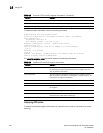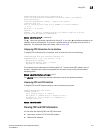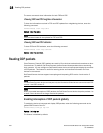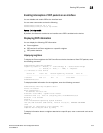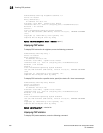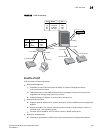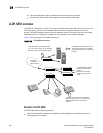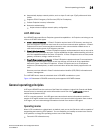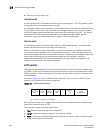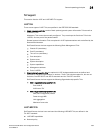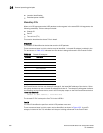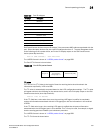
684 PowerConnect B-Series FCX Configuration Guide
53-1002266-01
Terms used in this chapter
24
The information generated by LLDP and LLDP-MED can be used to diagnose and troubleshoot
misconfigurations on both sides of a link. For example, the information generated can be used to
discover devices with misconfigured or unreachable IP addresses, and to detect port speed and
duplex mismatches.
LLDP and LLDP-MED facilitate interoperability across multiple vendor devices. Dell PowerConnect
devices running LLDP can interoperate with third-party devices running LLDP.
The Dell LLDP and LLDP-MED implementation adheres to the IEEE 802.1AB and TIA-1057
standards.
Terms used in this chapter
Endpoint device – An LLDP-MED device located at the network edge, that provides some aspect of
IP communications service based on IEEE 802 LAN technology. An Endpoint device is classified in
one of three class types (I, II, or III) and can be an IP telephone, softphone, VoIP gateway, or
conference bridge, among others.
LLDP agent – The protocol entity that implements LLDP for a particular IEEE 802 device.
Depending on the configured LLDP operating mode, an LLDP agent can send and receive LLDP
advertisements (frames), or send LLDP advertisements only, or receive LLDP advertisements only.
LLDPDU (LLDP Data Unit) – A unit of information in an LLDP packet that consists of a sequence of
short variable length information elements, known as TLVs. LLDP pass-through is not supported in
conformance to IEEE standard.
MIB (Management Information Base) – A virtual database that identifies each manageable object
by its name, syntax, accessibility, and status, along with a text description and unique object
identifier (OID). The database is accessible by a Network Management Station (NMS) using a
management protocol such as the Simple Network Management Protocol (SNMP).
Network connectivity device – A forwarding 802 LAN device, such as a router, switch, or wireless
access point.
Station – A node in a network.
TLV (Type-Length-Value) – An information element in an LLDPDU that describes the type of
information being sent, the length of the information string, and the value (actual information) that
will be transmitted.
TTL (Time-to-Live) – Specifies the length of time that the receiving device should maintain the
information acquired through LLDP in its MIB.
LLDP overview
LLDP enables a station attached to an IEEE 802 LAN/MAN to advertise its capabilities to, and to
discover, other stations in the same 802 LAN segments.
The information distributed by LLDP (the advertisement) is stored by the receiving device in a
standard Management Information Base (MIB), accessible by a Network Management System
(NMS) using a management protocol such as the Simple Network Management Protocol (SNMP).
The information also can be viewed from the CLI, using show LLDP commands.
Figure 115 illustrates LLDP connectivity
.



